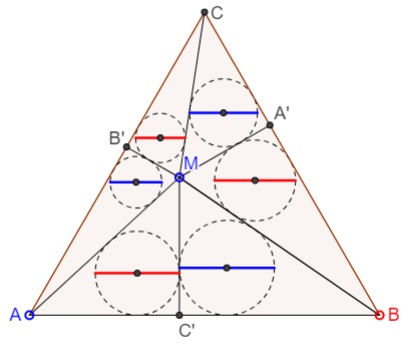Six Incircles in an Equilateral Triangle
What is it about?
A Mathematical Droodle
|Activities| |Contact| |Front page| |Contents| |Geometry|
Copyright © 1996-2018 Alexander BogomolnyThe applet purports to illustrate one of the many properties of an equilateral triangle.
Let M be a point inside an equilateral triangle ABC, with pedal points A', B', and C', as shown. The lines joining M to the six points split the triangle into six smaller ones. Circles are inscribed into each of the latter.

If the diameter of the incircle of triangle UVW is denoted d(UVW), the applet suggests that
(1)
d(AMB') + d(BMC') + d(CMA') = d(A'MB) + d(B'MC) + d(C'MA).
For a proof, note that all six triangles are right, with the right angles at the pedal points A', B', C'. For a right triangle with legs a and b and the hypotenuse c, the inradius r is determined by
(2)
2r = a + b - c,
see the diagram in the Proof #33 of the Pythagorean proposition. With (2) in mind, (1) reduces to
(3)
AB' + BC' + CA' = A'B + B'C + C'A.
Draw AbAc||BC, BaBc||AC, and CaCb||AB. This gets us three equilateral triangles with the pedal points A', B', C' as the midpoints of their bases. That is to say,
(4)
A'Bc = A'Cb
B'Ca = B'Ac
C'Ab = C'Ba.
Substituting (4) into (3) and noting that, e.g.,
(5)
ACa + BAb + CBc = BCb + CAc + ABa.
Finally observe that
(6)
ACa = BCb
BAb = CAc
CBc = ABa,
which proves (5).
References
- T. Andreescu, B. Enescu, Mathematical Olympiad Treasures, Birkhäuser, 2004
|Activities| |Contact| |Front page| |Contents| |Geometry|
Copyright © 1996-2018 Alexander Bogomolny73526475
